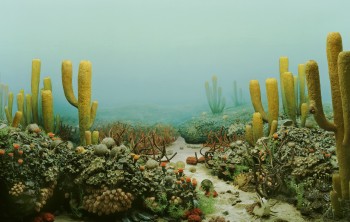Rachel Wood: Geochemical Clues Unearthed to Paleozoic Extinction
October 13, 2016

By Barbra Rodriguez
Death from greenhouse gases, a wallop from a meteorite or a big freeze? Rachel Wood, a carbonate geoscientist from the University of Edinburgh, is among the experts who now believe the largest extinction to hit Earth was an inside job, triggered by volcanic release of gases from within the Earth rather than glaciation or other causes.
In April 2016, as part of the DeFord lecture series at the Jackson School, she outlined her understanding of the chemical players in this tragedy known as the “Great Dying” that occurred some 252 million years ago at the end of the Permian period.
“Somewhere between 90 and 95 percent of all species went extinct,” Wood said. “It was really extremely catastrophic.”
She described how the Siberian Traps, a hilly region that covers upwards of 123 million acres, have become recognized as the culprit of the extinction. In particular, the timing of ancient volcanic eruptions from this region correlates with two waves of die-offs that ended the Paleozoic era. Emphasizing the impact on marine life, Wood reviewed some of the major atmospheric and oceanic changes that likely resulted from volcanic eruptions.
“You really have to look at the whole, holistic Earth system to understand the response when you’re dealing with a mass extinction,” Wood said.
A key tool has been studying carbon and other chemicals as their different forms cycle between land, air and water. The Siberian volcanoes would have unlocked carbon from the Earth’s mantle as dissolved carbon dioxide (CO2) in molten magma that spewed from volcanic vents. Wood summarized how the ratio of different carbon isotopes found in Permian fossils and rocks revealed that the first extinction phase likely stemmed from atmospheric injection of organic carbon from magmatic CO2. This greenhouse gas would have blanketed and warmed the atmosphere. In addition, the CO2 probably spread to oceans, poisoning certain marine organisms during the first extinction phase. One theory suggests that brachiopods, sponges, crinoids and other creatures had slower metabolisms than other marine life and couldn’t protect themselves against concentrated CO2 in the water.
Additionally, the greenhouse gas-induced global warming likely altered ocean circulation patterns and reduced oceans’ dissolved oxygen, potentially suffocating some marine species.
“There’s no doubt that anoxia is a key player globally,” Wood said of the early phase of the extinction. Elevated atmospheric CO2 likely also triggered a more widespread, second extinction phase, 60,000 or so years after the end of the first phase. Wood described how oceans initially could have maintained their acidity level because aqueous CO2 (and the bicarbonate produced when it dissolves) can serve as an alkalinizing buffer. However, at some point in the million years or so that the Siberian Traps were volcanically active, the oceans’ buffering capacity probably became overwhelmed by
the hydrogen ions released during the break down of CO2. Increased acidity could have directly or indirectly caused marine life such as bivalves and gastropods that had survived the earlier extinction to lose the ability to make shells and reproduce.
With that background, Wood covered her research into the geochemical details of this extinction. She has used borate isotope analyses of ancient brachiopod fossils samples that were collected from the Arabian Peninsula as a proxy for pH changes. That approach uncovered the surprising possibility that Permian oceans became alkalinized well before the first extinction phase. Quantitative models also suggest that the rate of atmospheric CO2 release was relatively slow during much of the formation of the Siberian Traps.
The Arabian borate samples also support the theory that the marine pH plummeted 60,000 years after the first extinction phase. A rapid Siberian release of CO2 has been suggested as causing that acidification —which lasted about 10,000 years—and the extinction of most remaining marine species.
“It’s a really dramatic acidification event,” Wood said. Using the boron isotope excursion pattern to extrapolate backward, she and her colleagues suggest that atmospheric CO2 levels had to rapidly climb three times above background to produce the pH drop and the second extinction phase in the Paleozoic.
She noted that understanding the impacts of the slow CO2 release that started closing the curtain on this era, and the subsequent ocean acidification, could inform discussions about how modern increases in CO2 may impact the environment.
“I leave it to you to decide how good an analog this is,” Wood said. “Is this just an extraordinary event and more doom saying? Nonetheless, I think there are lessons here.”
Back to the Newsletter